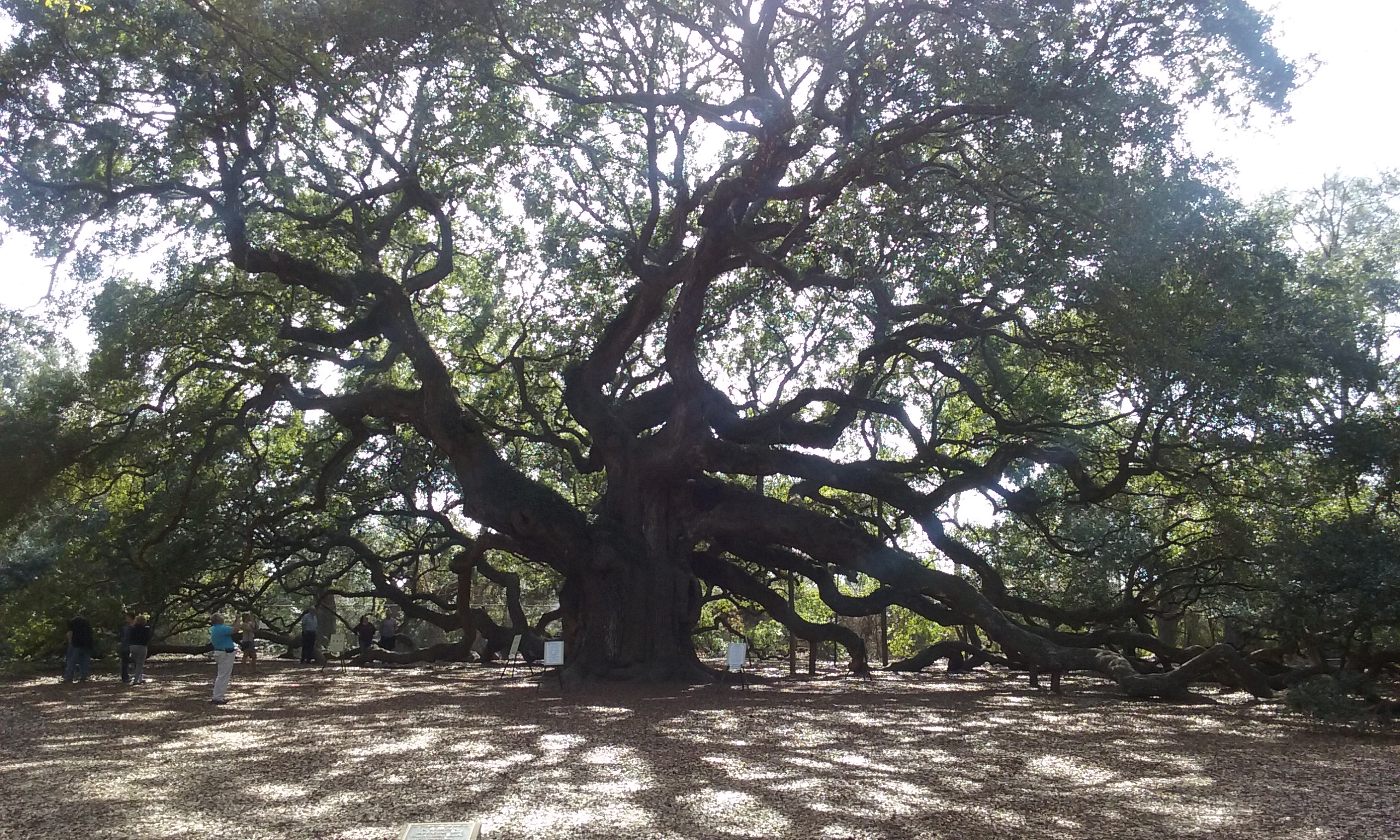Eileen and I love driving through a tunnel of trees and in the coastal plain of the southern states, one can find many locations meeting this description. A large tree with huge arching branches draped with Spanish moss, the live oak, Quercus virginiana Mill.(1), epitomizes the Deep South. Hollywood only needs to show images of this tree and the viewer immediately recognizes the stories location.

As we visit natural areas and plantations around the Charleston area, we cannot miss the abundance of live oaks. At each location stories abound as to the age and history of the trees. The Washington Oak resides at the Hampton Plantation where family legend claims that when George Washington visited (a well-documented fact) in 1791, the owner asked if they should remove the oak that blocked the view from the portico and he advised them to keep it. The tree still stands making it well over 320 years old.(2)

An image from Trip Advisor where you can learn more about this place.
At the Middleton Plantation one can find the former champion live oak which lost its status when two major limbs came off.

The guide driving the horse-drawn carriage at Middleton informed us that the concrete packed inside of the tree closest to the remaining plantation house was placed in there just after the Union soldiers burned the plantation to the ground in February 1865. Assuming the veracity of this statement, the tree must have been pretty large 152 years ago.

Some sources of information on the Angel Oak with its spreading limbs cascading over the ground dwarfing the many people visiting claim a tree over 1,500 years (if you type “age of Angel Oak” into a search engine, you may see a Wikipedia page with this claim, but if you actually click on the link, that information is no longer on the page—bad information never disappears from the web) while the most recent assessment puts the age somewhere between 375 and 600 years old—still impressive.(3) Enjoy pictures of this magnificent tree at http://www.sciway.net/sc-photos/charleston-county/angel-oak.html

Last year, we stopped by the Gulf Island National Seashore’s Naval Live Oak Area near Gulf Breeze, Fl. There we learned that back in 1828, the Federal Government set up a tree farm to grow live oaks.(4) Why? Ships. Relatively short, stout, and spreading live oak trees survive well in the sandy soils occasionally slammed by hurricanes. The short stature and very dense wood that twists as it grows, making it difficult to work. Yet, these characteristics also made the wood highly desirable for specific uses on wooden ships. Live oaks with their huge strong arching branches provided critical shapes for the curved supports for the hulls of ships. The heavy junctions between the branches and the trunk provided excellent wood for the ships “knees”—short pieces that strengthen the design and other critical parts.(5) You might get a feel for what I am talking about by viewing this u-tube video of a piece being made out of live oaks destroyed by Hurricane Katrina for the Charles W. Morgan in Mystic, CT. https://www.youtube.com/watch?v=nqUQ8jARdy4 and https://www.youtube.com/watch?v=ser-LoAxYOE or https://www.youtube.com/watch?v=3jEwALzzOkg&index=7&list=PL22AA710488CD330E
Live oaks grow fast and huge. In only 70 years of optimal growth, these trees might grow to 54 inches d.b.h.(6)—that is huge. The really dense wood prohibits scientist from collecting core samples and by the time a tree dies, heart rot destroys much of the early growth rings, making aging a tree very difficult.
On page 17 of Natural History of Carolina, Florida and the Bahama Islands, Tome, 1 by Mark Catseby and revised by Mr. Edwards in 1754 (I changed the shape of the “s” for easy reading, but kept the spelling errors) it says:
“The acorns are the sweetest of all others; of which the Indians usually lay up store, to thicken their venison-soop, and prepare the, other ways. They likewise draw an Oil, very pleasant and wholesom, little inferior to that of Almonds.”(7)
If you want to know more about preparing acorns for consumption, I recommend this page http://www.eattheweeds.com/acorns-the-inside-story/. What I learned was, I don’t want to try it.
- https://plants.usda.gov/plantguide/pdf/pg_quvi.pdf accessed on 2/10/17.
- http://south-carolina-plantations.com/charleston/hampton.html accessed 2/11/17.
- http://www.monumentaltrees.com/en/trees/liveoak/liveoak/ accessed 2/11/17.
- https://www.nps.gov/guis/learn/historyculture/the-live-oak-story.htm accessed on 2/10/17.
- http://www.navyandmarine.org/ondeck/1800shipconstruction.htm accessed on 2/10/17.
- Harlow, William M.; Harrar, Ellwood S., White, F. M. 1979. Textbook of dendrology. 6th ed. New York: McGraw-Hill, Inc. 510 p. quoted in https://www.fs.fed.us/database/feis/plants/tree/quevir/all.html#20 accessed 2/10/17.
- http://lhldigital.lindahall.org/cdm/compoundobject/collection/nat_hist/id/649/show/434/rec/2 accessed on 2/14/17.

Comments
2 responses to “One of THE South’s Iconic Trees”
I love trees! And as you must know in your tiny town of Bristol, PA there is a Sycamore Tree that was alive when William Penn walked these woods in 1682. You do the math! It’s in the Bristol Friends Meetinghouse at the corner of Wood and Market Streets for all to see.
Mercy Ingraham
Thanks Merc! I care……Love trees too